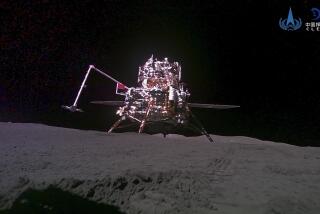NASA’s moon crash is no spectacle, but could be a success
Reporting from Mountain View, Calif. — As entertainment, NASA’s moon punch mission was more “Heaven’s Gate” than “Raiders of the Lost Ark.” As science, however, it might still qualify for blockbuster status.
Huddled in sleeping bags and tents, hundreds of people had gathered on a chilly Bay Area evening Thursday in front of a big outdoor screen to await what they hoped would be a celestial fireworks display as a NASA rocket plunged into a dark crater in search of ice on the moon. The Friday crash was supposed to send up a debris plume big enough to be seen from some Earth-based telescopes; a following spacecraft was to fly through plume and analyze its contents.
In the end, the plume failed to show on the screen, leaving many in the crowd outside Ames Research Center, along with those watching on NASA television, disappointed. All that appeared when the crash occurred at 4:31 a.m. was a close-up view of the craggy landscape at the moon’s south pole. Then the picture went dark as the following spacecraft also crashed, as planned, leaving viewers scratching their heads and wondering what they had seen.
“We all expected to see something,” said David Morrison, head of the Lunar Science Institute at the research center, which managed the mission. “In that sense it was a disappointment.”
Some scientists suspect the camera settings on the second spacecraft were incorrect, preventing it from spotting the plume. But they were hopeful that the plume did occur and that observatories worldwide watching the event were able to detect the plume’s contents.
Mike Bicay, the director of science at Ames, said an infrared camera aboard the second spacecraft picked up changes in temperature as it neared the moon. That could be an indication, he said, that it was flying through the plume kicked up by the Centaur rocket. If so, scientists might still pluck success from the mission’s anticlimactic ending.
Until all the facts are in, “I’m going to remain cautiously optimistic,” Bicay said.
At a news conference more than two hours after the crash, mission scientists confirmed that the Centaur rocket made a crater when it hit, and that the crater was about the expected size of more than 60 feet across. Also, they said, spectrometer data did record a flash upon impact that researchers are scrambling to understand. It could take days or weeks to determine what that flash means and whether any of the instruments onboard the spacecraft and at observatories around the world picked up the signature of water on the moon’s surface.
“We just don’t know right now what we saw entirely,” said Tony Colaprete, the mission’s project scientist. But “we got spectrometer data and that’s what really matters.”
Spectrometers are adept at breaking down the light from the collision to reveal what chemical compounds were in the debris kicked up by the crash, if any.
The Lunar Crater Observation and Sensing Satellite launched in June to find out whether water ice might lie hidden at the bottom of polar craters that haven’t seen sunlight in billions of years.
That had been an open question since the Lunar Prospector mission detected large quantities of hydrogen at the south pole in 1998. Hydrogen is a marker for water. Scientists hypothesized that the water might have been delivered to the moon the same way it accumulated on Earth, through millions of years of bombardment by water-bearing comets and meteorites.
The LCROSS spacecraft was designed to steer the Centaur rocket into a crater called Cabeus, where especially large amounts of hydrogen had been measured. After the Centaur crashed, the spacecraft was supposed to fly through the debris kicked up by the impact. The spacecraft’s nine instruments were designed to detect the presence of water, if it’s there.
According to Morrison, the mission appeared to go according to plan, except for the fact that no plume showed up on camera. Even with that disappointment, many in the crowd watching the event applauded.
Lindsey Pollock, a 24-year-old graphic designer from Mountain View, was delighted with the show. “I thought it was all very exciting,” she said.
“You could see the camera getting closer and closer to the moon. I thought of all the hard work that went into the mission,” she said.
Besides the LCROSS spacecraft, the collision was viewed by the Hubble Space Telescope, the giant Keck telescopes in Hawaii and the Lunar Reconnaissance Orbiter, which is mapping the moon from a distance of just 31 miles above the lunar surface.
Bicay said it is possible one or more of those instruments was able to see the plume that failed to appear on-screen Friday morning.
It is also possible, Colaprete said, that the Centaur rocket hit bedrock at the bottom of the crater and failed to create a plume of debris. Or it could have gone into the crater at an angle that sent the debris plume shooting out parallel to the ground.
“We need to go back and look at the data. I see something in the spectrometer but I can’t say anything more right now,” Colaprete said.
It is likely to be days before all the science results are analyzed and NASA finds out whether it has a hit or a flop on its hands.
“This is what exploration is,” said Michael Wargo, chief lunar scientist at NASA headquarters in Washington.
More to Read
Sign up for Essential California
The most important California stories and recommendations in your inbox every morning.
You may occasionally receive promotional content from the Los Angeles Times.










